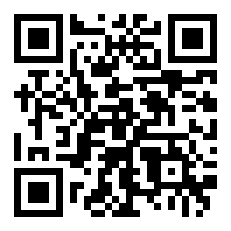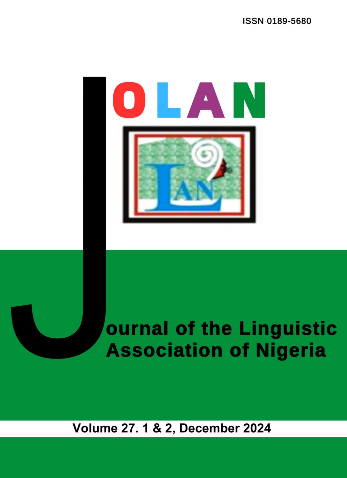Online Flaming: An Analysis of the Semiotic Elements in Senator Dino Melaye's videos to his perceived Opponents in Nigeria
Keywords:
kinesthetic, verbal, visual rhetoric, Senator Dino Melaye, imaginary audienceAbstract
This paper explores elements of flaming in three videos of Senator Dino Melaye (SDM) to his perceived opponents in Nigeria. The study sees semiotic elements in the videos as argumentative tools meant to draw the imaginary audience into his line of reasoning. Applying concepts from multimodality by Kress and Van Leeuwen (1996), and the persuasive theory by Demirdöğen (2010), the study looks at the verbal and the kinesthetic of the videos and how they jointly cast the targets of the videos in a negative light. The aim of the study is to examine how the verbal complements the kinesthetic in casting the targets of the videos in a negative light. The objectives of the study are: to find out the persuasive techniques, mannerisms deployed in SDM’s videos to cast the targets in a negative light; to establish how the verbal complements the kinesthetic in casting targets of the videos in a negative light. The justification for the study derives from the belief that meanings projected in the speeches of public figures especially those posted online can easily be taken as the ideal. The videos were downloaded from YouTube and transcribed. Some parts of the verbal aspects which were in the Yoruba language were transliteration into English. Snapshots of the kinesthetic were taken and analysed alongside the verbal. The study found that the eye contact with the imaginary audience, his aggressive body movement helped him to establish ethos—positioning him as being capable of carrying out all the threats in the video; the verbal complements the kinesthetic in a synchronized way, in that the kinesthetic matched each word he said reinforcing the threads and aspersions in the video; there are similar body movement in all the videos, like gesticulating with his hands, dancing to the tune of the song he composed and engaging in acts as if physically fighting with his opponent. The study recommends that, utterances which have the propensity to demean its target especially of public figures should be free of derogatory and abusive items.
References
Alonzo, M., & Aiken, M. (2004). Flaming in electronic communication. Decision Support Systems, 36(3), 205-213.
Al-Momani, K.R. (2014). Strategies of Persuasion in Letters of Complaint in Academic Context: the Case of Jordanian University Students’ Complaints. Discourse Studies. Vol. 16(6), 705-728.
Amossy, R. (2000) Argumentation in Discourse: A Socio-discursive Approach to Arguments DOI: 10.22329/il.v29i3.2843
Amossy, R. 2000. El pathos o el rol de las emociones en la argumentación. In L´argumentation dans le discours París: Nathan.
Bernthal, K. (1995), Online transmission of inflammatory remarks, PC Novice, 6, 39-40
Bezemer, Jeff; Gunther Kress (April 2008). ‘‘Writing in Multimodal Texts: A Social Semiotic Account of Designs for Learning’’. Written Communication 25 (2): 166–195. doi:10.1177/0741088307313177.
Blair, J.A. (2004). The rhetoric of visual arguments. In Defining Visual Rhetorics, ed. Charles A. Hill, and Marguerite Helmers, 41–62. Mahwah; N.J/London: Lawrence Erlbaum.
Blair, J. A. (2015). Probative norms for multimodal visual arguments. Argumentation. doi: 10.1007/s10503-014-9333-3.
Butler, Judith. (1997). Excitable Speech: A Politics of the Performative. New York: Routledge.
Connors, R. J. (1979). The Differences Between Speech and Writing: Ethos, Pathos, and Logos. College Composition and Communication. Vol. 30(3), 285-290.
Demirdöğen, Ü. D. (2010). The Roots of Research in (Political) Persuasion: Ethos, Pathos, Logos and the Yale Studies of Persuasive Communications. International Journal of Social Inquiry. Vol. 3(1), 189-201.
Eemeren, F. H. van (ed.): (2001) Crucial Concepts in Argumentation Theory, Amsterdam University Press, Amsterdam.
Eemeren F. H. van (2011). Strategic Maneuvering in Argumentative Discourse. Extending the Pragma-Dialectical Theory of Argumentation. Argumentation 25, 261–270 (2011) doi:10.1007/s10503-011-9202-2
Eemeren, F.H. van and Bart Garssen (2012). Exploring Argumentative Contexts. Amsterdam/Philadelphia: John Benjamins.
Gabrielsen, J. & Christiansen, T. J. (2010). The Power of Speech. Denmark: Gyldendal.
Higgins, C. & Walker, R. (2012). Ethos, Logos, Pathos: Strategies of Persuasion in Social/environmental Reports. Accounting Forum. Vol. 36, 194-208.
Kjeldsen, J. E. (2002). Visuel retorik[Visual rhetoric ]. Ph.D. thesis, Department of Media Studies, University of Bergen, Bergen
Kjelsden, J.E. (2016) Studying Rhetorical Audiences: A Call for Qualitative Reception Studies in Argumentation and Rhetoric. In Informal Logic 36(2): 136-158
Kress, Gunther, and Theo van Leeuwen, (1996). Reading Images: The grammar visual design. London: Routledge.
Kress, Gunther, and Theo Van Leeuwen (2001). Multimodal Discourse: The Modes and Media of Contemporary Communication. London: Arnold.
Kress, Gunther. (2010). Multimodality: A Social Semiotic Approach to Contemporary Communication. London: Routledge.
Moor, P.J. (2007), Conforming to the flaming norm in the online commenting situation.
Mshvenieradze, T. (2013). Logos, Ethos and Pathos in Political Discourse. Theory and Practice in Language Studies. Vol. 3(11), 1939.
Naksawat, C., Akkakoson, S. & Loi, C.K. (2016). Persuasion Strategies: Negative Forces in Scam Emails. GEMA Online® Journal of Language Studies. Vol. 16(1), 1-17.
Waldron, Jeremy. (2012). The harm in hate speech. Cambridge, Mass.: Harvard University Press.
Web sources
(11 THE DECEMBER 2018) http://www.informationng.com/2018/12/video-dino-Melaye-releasesnew-song-says-buhari-responsible-for-hunger-and-poverty.html
Ajeku eya noje http://www.informationng.com/2018/03/ajekun-eya-noje-senator-dino-Melayereleases-hilarious-video-message-to-gov-yahaya-bello.html
Say No to poverty and hunger
https://www.instagram.com/p/BrLp_5znUc1/?utm_source=ig_embed&utm_campaign=embed_video_watch_again
Dino Melaye denies gun running, lambasts Yahaya Bello
March 21, 2018 https://www.youtube.com/watch?v=qLHIDetAOkg
See section 39(1), Constitution, Federal Republic of Nigeria 1999 as Amended in 2011














